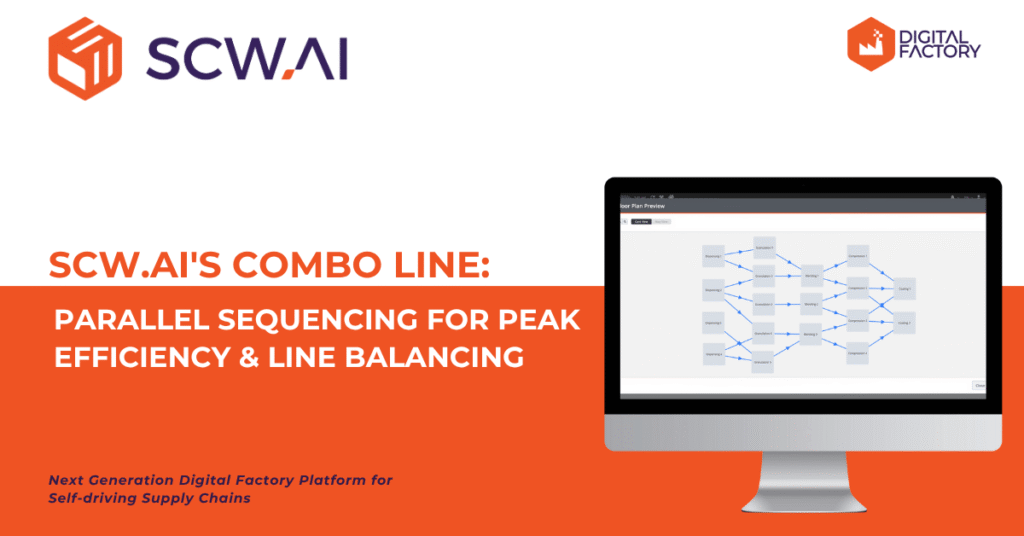Scheduling optimization can lead to significant improvements in manufacturing KPIs such as OEE, OTIF delivery, and production capacity. However, achieving these results requires overcoming the complexities of scheduling, which involves balancing multiple factors and quickly adapting to unexpected disruptions.
SCW.AI’s AI Scheduler empowers manufacturing planners by offering automated schedule simulations with optimization result comparisons. This tool enables managers to evaluate multiple scenarios and select the best one based on specific business objectives, such as cost minimization, changeover reduction, or just-in-time scheduling.
In this article, we explore the key concepts behind scheduling optimization and discuss how manufacturers can leverage both mathematical and digital solutions to optimize their operations. We also present five different optimization scenarios, analyzing when and how each can be most effectively applied to drive better business outcomes.
What is Scheduling Optimization?
Scheduling optimization for manufacturers refers to the process of allocating resources—such as labor, equipment, and materials—to produce the required goods in a way that maximizes business objectives, while adhering to various operational constraints. An optimal schedule balances factors like efficiency, cost, timely delivery, stock minimization and so on.
It is important to recognize that factories operate in dynamic environments where internal and external disruptions can frequently arise. From equipment breakdowns to supply chain delays, these unforeseen events can challenge even the most well-planned schedules. Therefore, scheduling optimization must often be dynamic, enabling agile manufacturing practices that quickly adapt to changing conditions.
As we will explain in more detail, seven key factors influence scheduling optimization, each playing a critical role in job shop scheduling.
7 Components of Schedule Optimization
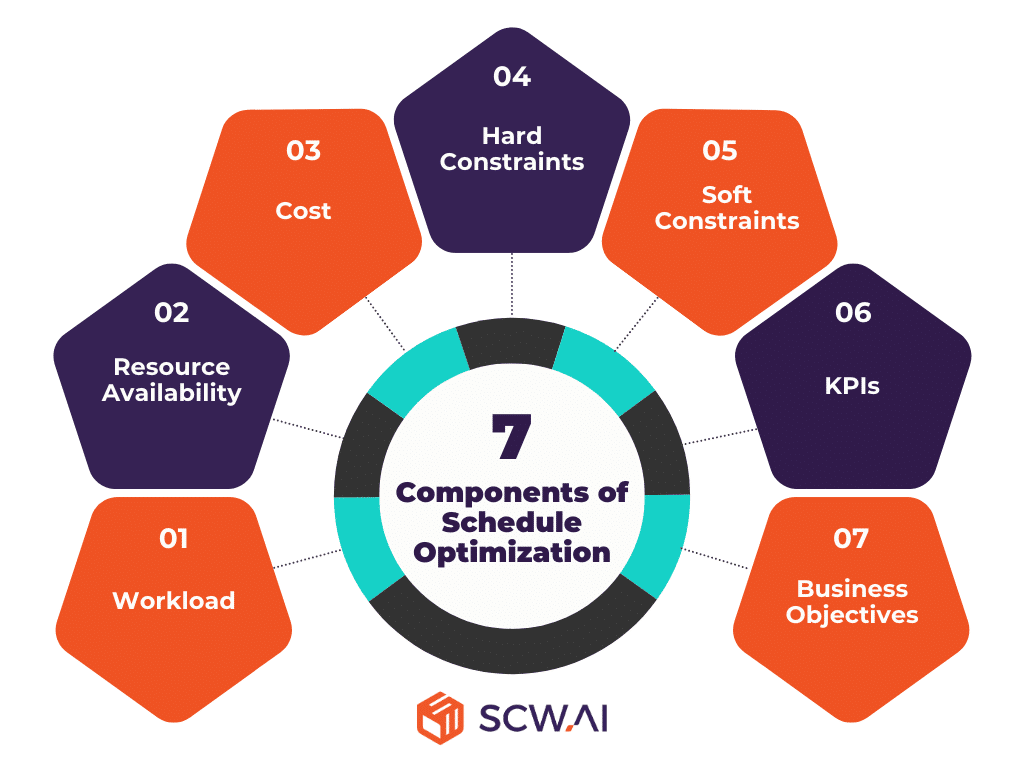
1. Actual OEE
For manufacturers, workload represents the demand for different products, each with a specified due date. Accurately estimating future demand is critical for organizing supply chain relationships and ensuring production runs smoothly. AI-driven advanced planning and scheduling tools can provide highly accurate demand forecasts, helping manufacturers anticipate and manage workload effectively as discussed in SCW for Pharma Podcast.
2. Resource Availability
Resource availability—including production lines, shift schedules, workforce, and raw materials—is crucial for effective scheduling optimization. Without real-time knowledge of available resources, planners cannot create realistic or efficient schedules. Our Scheduler provides up-to-date resource information through a centralized dashboard, giving manufacturers the transparency they need to manage production in real time.

3. Cost
Production cost is a key factor in scheduling optimization, as there is often a tradeoff between minimizing costs and meeting deadlines. For example, speeding up production to meet tight deadlines may require additional resources, increasing costs. Having access to real-time cost data, displayed automatically by our scheduling optimization software based on input values, simplifies managing cost trade-offs.

4. Hard Constraints
Hard constraints are mandatory conditions that must be followed to ensure production quality and regulatory compliance. For example, in the pharmaceutical industry, certain processes—like coating—cannot be performed on packaging lines, and granulation must occur before encapsulation. Additionally, some hard constraints, such as controlled waiting times between processes, help maximize first pass yield and minimize scrap and rework.
5. Soft Constraints
Soft constraints are preferences that, while not mandatory, are often desirable for manufacturers. For instance, while a schedule may assign a particular task to a production line, planners may prefer to assign the task to workers who have more experience with that product to improve efficiency.
6. KPIs
Optimized schedules should aim to meet or exceed certain manufacturing KPIs that are important to production planners, such as schedule adherence, OEE, and capacity utilization. Having real-time access to projected KPI outcomes on the scheduling dashboard allows planners to evaluate the effectiveness of their schedules and make adjustments as needed.
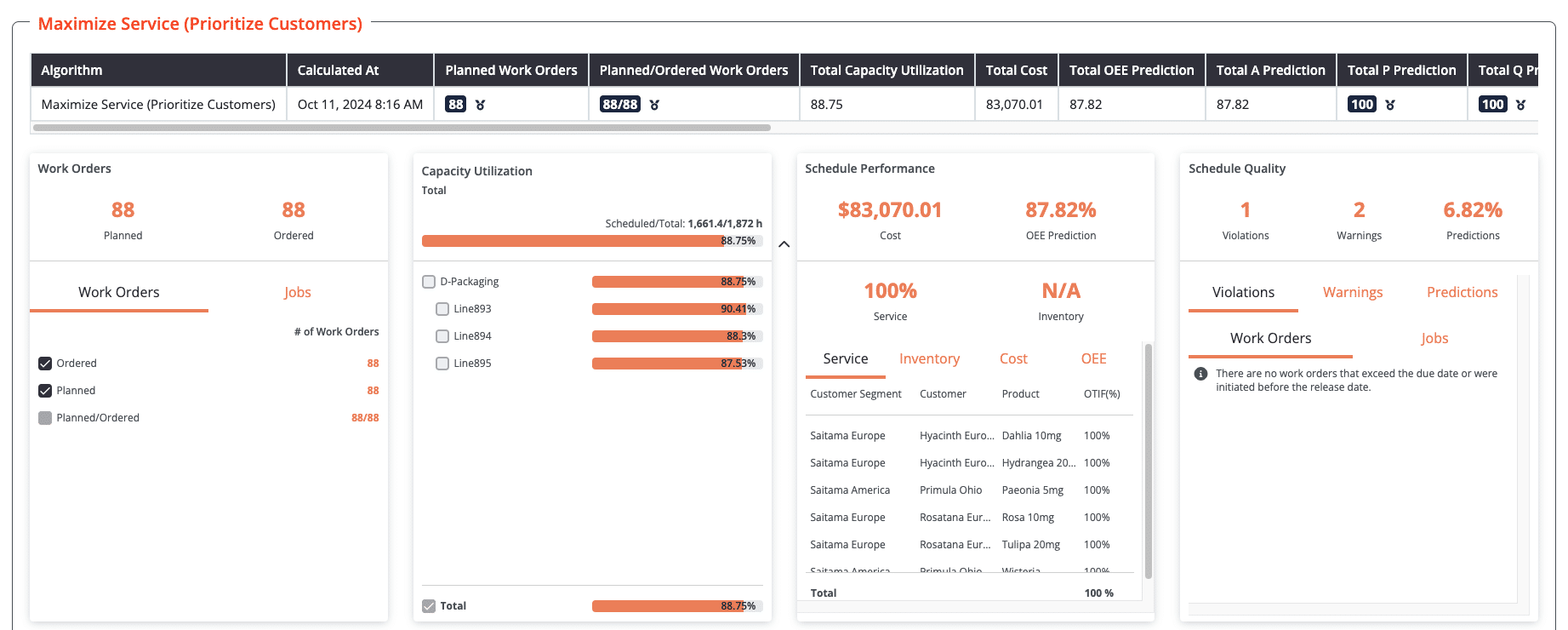
7. Business Objectives
Business objectives define the goals that guide scheduling decisions. For instance, a manufacturer may prioritize just-in-time delivery to ensure product freshness, but this could lead to lower OEE and a higher risk of stockouts if there is a sudden demand surge. Alternatively, a manufacturer might prioritize profit maximization by focusing on high-margin products, even if it means some orders will be delivered late. The ability to align scheduling with different and unique business objectives is a key strength of SCW.AI’s optimization tools.

Schedule Optimization Model
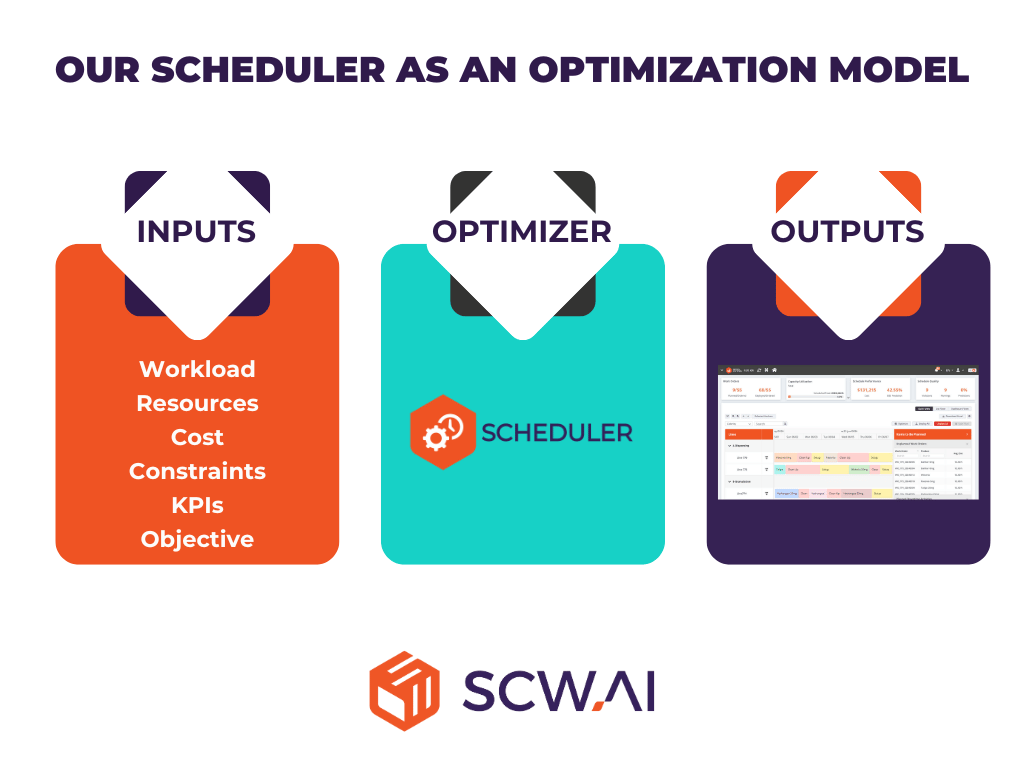
The Schedule Optimization Model is a digital tool designed to solve manufacturers’ scheduling challenges. It gathers inputs—such as demand, resource availability, and business objectives—and transforms them into optimized schedules.
One of the key advantages of our Scheduler is its AI-driven intelligent automation. The AI algorithms are capable of adjusting to different scheduling objectives, allowing manufacturers to optimize for various factors with a single click (See Video). Planners can further refine these schedules through an intuitive digital interface, making adjustments in real time to respond to unforeseen changes or improve AI schedules.
To discover the AI HUB the technology behind one click schedules click the button below.
Optimization Techniques
Manufacturing scheduling optimization typically relies on three key techniques:
1. Mathematical Optimization
Mathematical optimization methods, such as linear programming and mixed integer programming, are used to create optimal schedules based on defined objectives and constraints.
2. Constraint Programming
Constraint programming finds schedules that meet all specified constraints. It ensures that schedules are feasible by identifying intersections where no constraints are violated, such as resource limitations or operational rules.
3. Optimization with Simulations
This technique uses AI to generate multiple schedule simulations, each optimized for different objectives. Planners can review each simulation, evaluating predicted KPIs, warnings about constraint violations, and how each schedule aligns with current business needs. Based on this data, they can choose the best draft and refine it further within the Scheduler. Thus, automated simulations allow planners to focus on high-value decision making tasks.
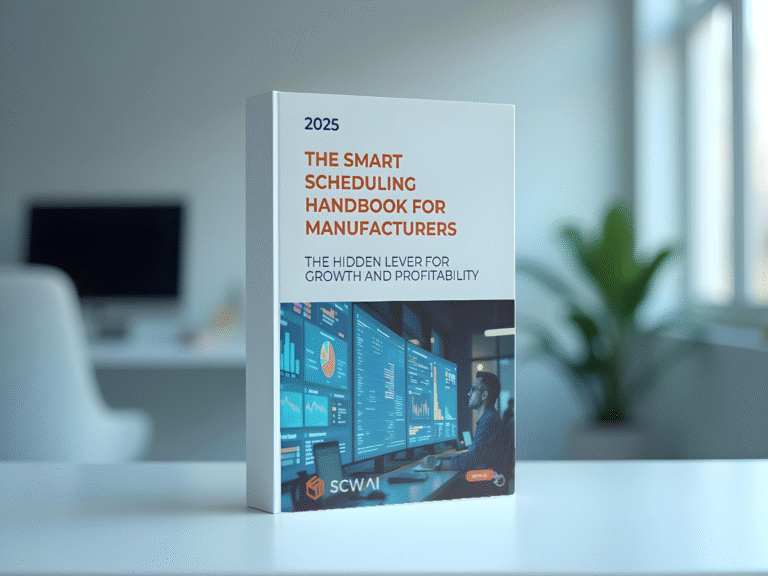
Manufacturers can now access the free Smart Scheduling Handbook, a comprehensive guide revealing how AI-powered Advanced Planning and Scheduling systems are revolutionizing job shop management. It offers a complete roadmap for preparing factory floors, showing how AI helps pinpoint near-optimal, dynamic production schedules—boosting resilience and cutting costs. Download your copy today
5 Different Scheduling Simulations With Our AI Scheduler
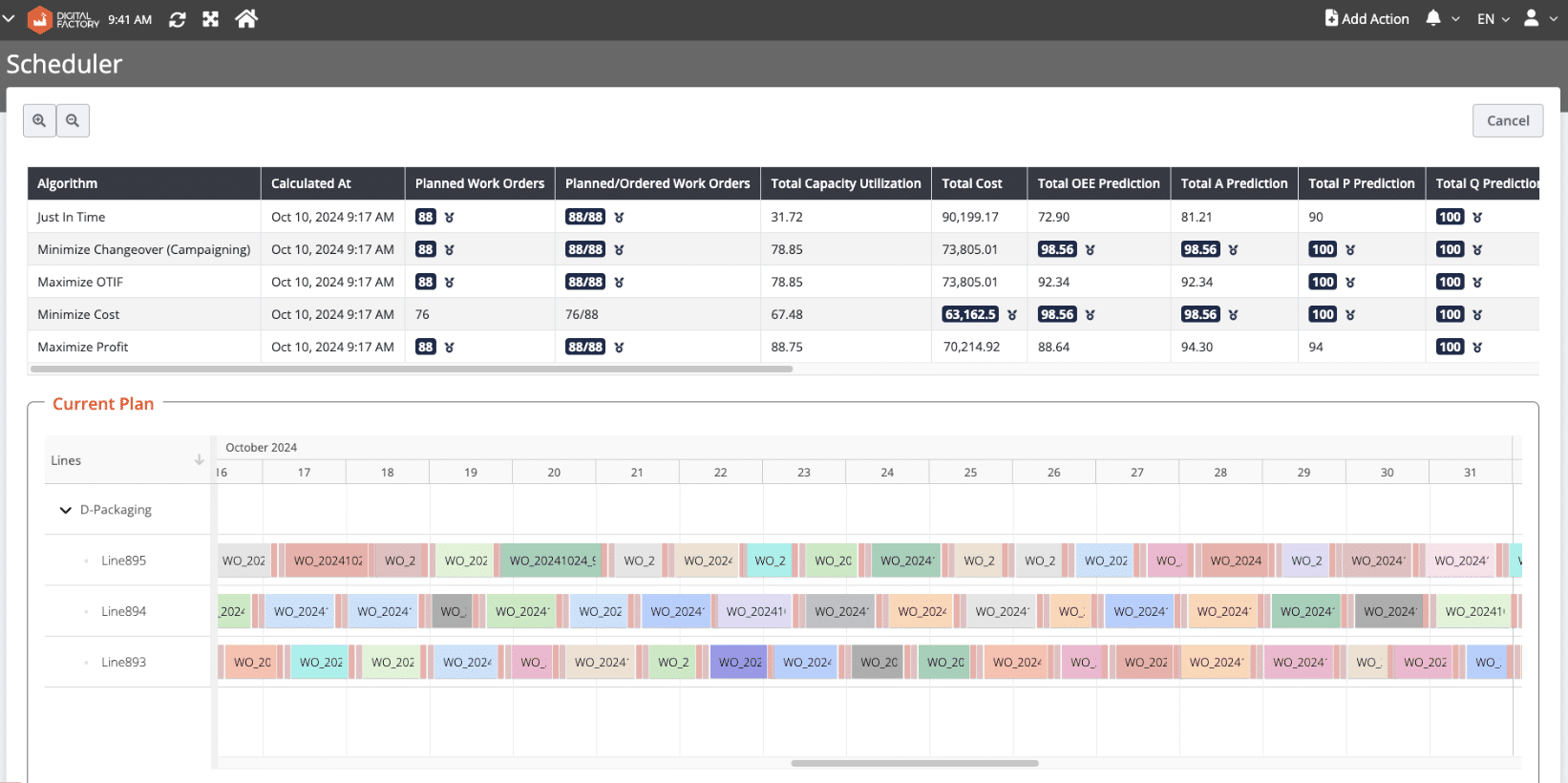
To demonstrate the power of our AI Scheduler, we ran demanded 88 work orders through five different AI algorithms, each focusing on a distinct objective:
- Just in Time
- Minimize Changeover
- Maximize OTIF
- Minimize Cost
- Maximize Profit.
The goal is to showcase how optimization result comparisons through simulations can be leveraged by planners. As shown in the image above, the AI model allocates work orders and generates optimized schedules for all five objectives in seconds—saving planners significant time which is already a success story of digital transformation.
In the following sections, we will explore the pros and cons of each algorithm, highlighting how different objectives can impact overall performance and help planners make informed decisions based on their current business needs.
1. Just in Time Scheduling

As shown in the image above, the Just in Time (JIT) algorithm successfully scheduled all 88 work orders, achieving a predicted OEE of 72.9%, with availability losses being the largest contributor to the OEE reduction. The capacity utilization rate of 31.72% is the lowest among the five algorithms, with total costs exceeding $90K.
These results are typical of a JIT schedule, where high costs and lower capacity utilization are expected. As the image below illustrates, JIT schedules include intentional pauses between work orders to ensure products are delivered exactly on their due dates. During these pauses, workers remain on-site, driving up labor costs, and idle times reduce capacity utilization. Additionally, since products from different families are often run consecutively, changeover processes tend to be longer, contributing to higher availability losses.
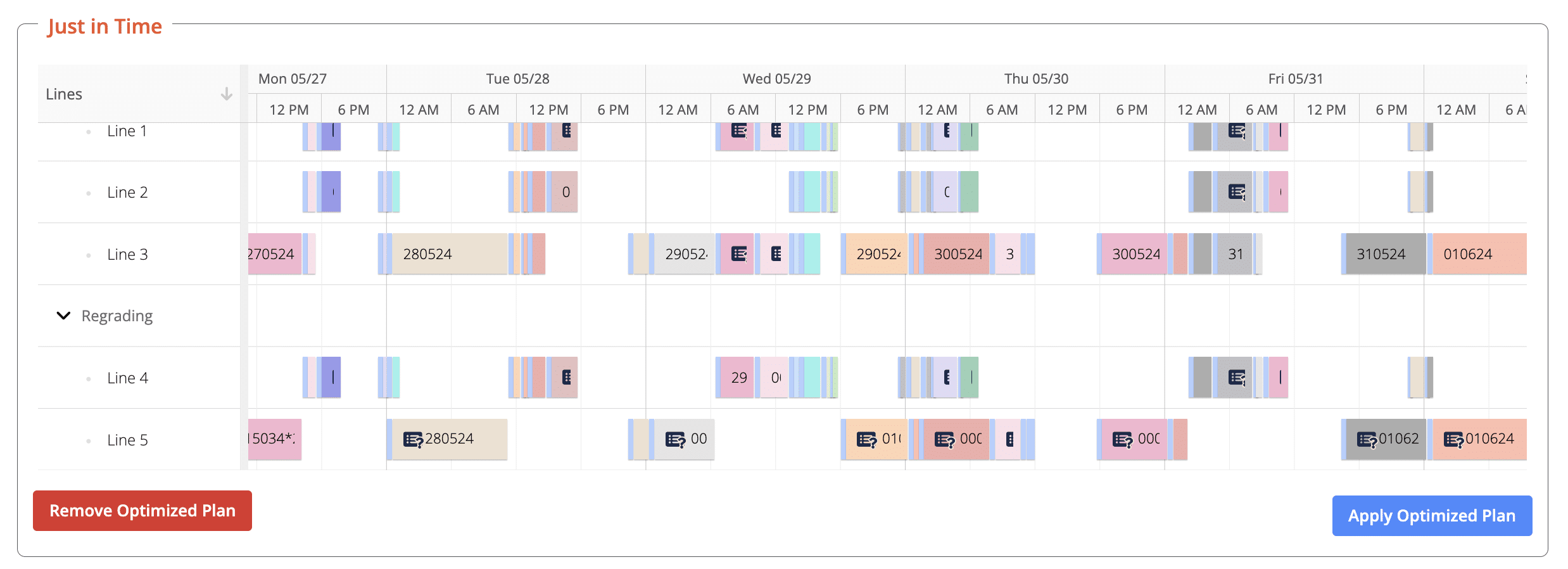
Despite these drawbacks, JIT scheduling ensures that products reach customers fresh or at their optimal functionality. This is especially crucial for manufacturers of perishable goods, such as food and beverage companies or radiopharmaceutical producers, as highlighted by Indranil Nandi, Chief Scientific Officer at Jubilant, in the sixth episode of SCW for Pharma Podcast (see the video below).
2. Changeover Minimization
As shown in the image below, the changeover minimization algorithm successfully scheduled all 88 work orders, achieving the highest availability score, which is expected when minimizing changeovers. The AI algorithm groups products from the same families together as much as possible, allowing for shorter line cleanings and faster machine setups.
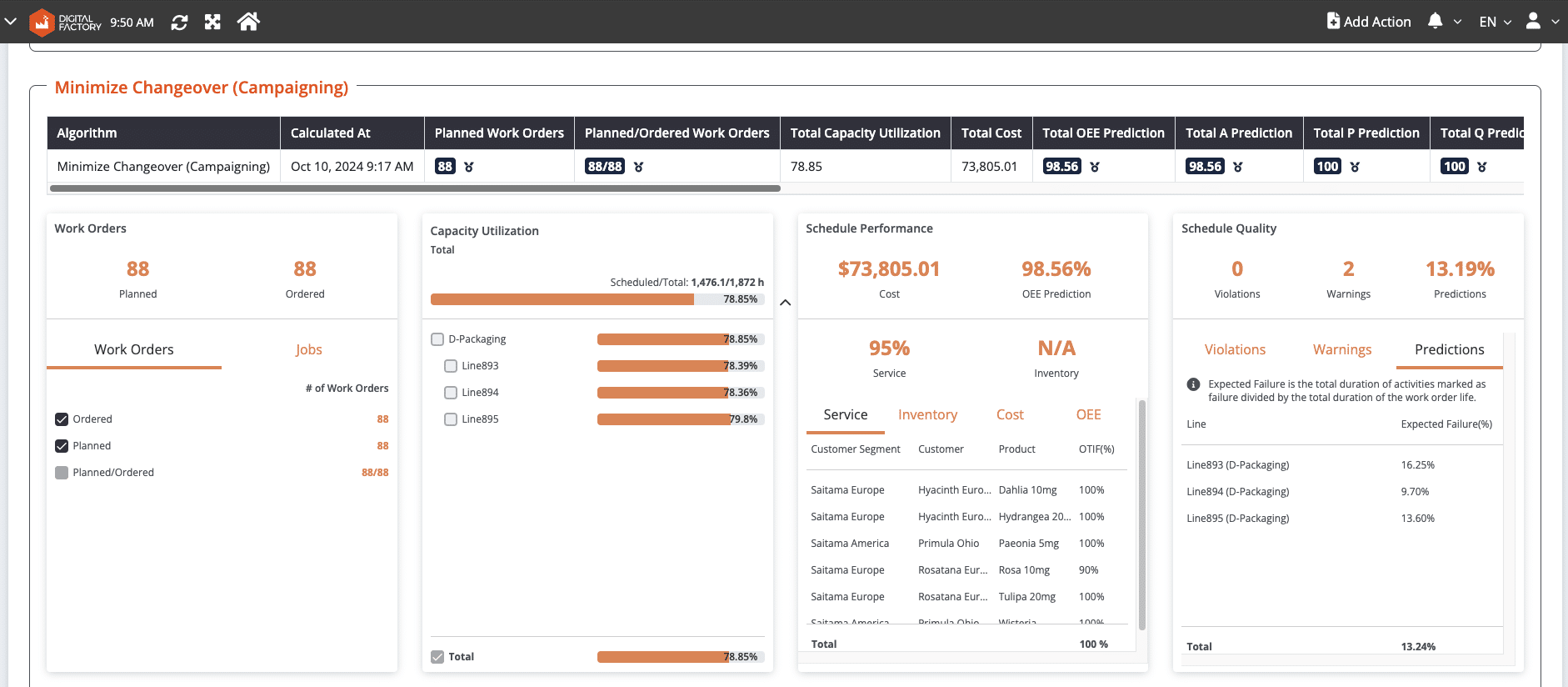
According to Boston Consulting Group, AI-driven changeover minimization is an effective strategy for improving OEE and reducing costs. This approach is particularly beneficial for pharmaceutical manufacturers, where line cleaning times are longer due to strict GMP compliance.
For more insights on how pharmaceutical manufacturers can enhance their monitoring, compliance, and agility, you can explore our article, Pharma 4.0: A Guide for Pharma Executives to Modernize Their Factories.
3. OTIF Maximization

The OTIF (On-Time In-Full) maximization algorithm is increasingly popular among manufacturers, as it ensures timely delivery of goods, enhancing client satisfaction and helping to avoid costly OTIF penalties—an issue that became more pressing post-pandemic.
In this simulation, the OTIF algorithm successfully scheduled all 88 work orders, achieving a relatively high OEE, which is typical in an OTIF-focused scenario.
One notable feature of our Scheduler is the OTIF Analysis Report, which provides detailed insights into delivery performance. Planners can identify customers with frequent late or incomplete deliveries and manually prioritize them in future schedules, ensuring that key clients receive their orders on time and in full.
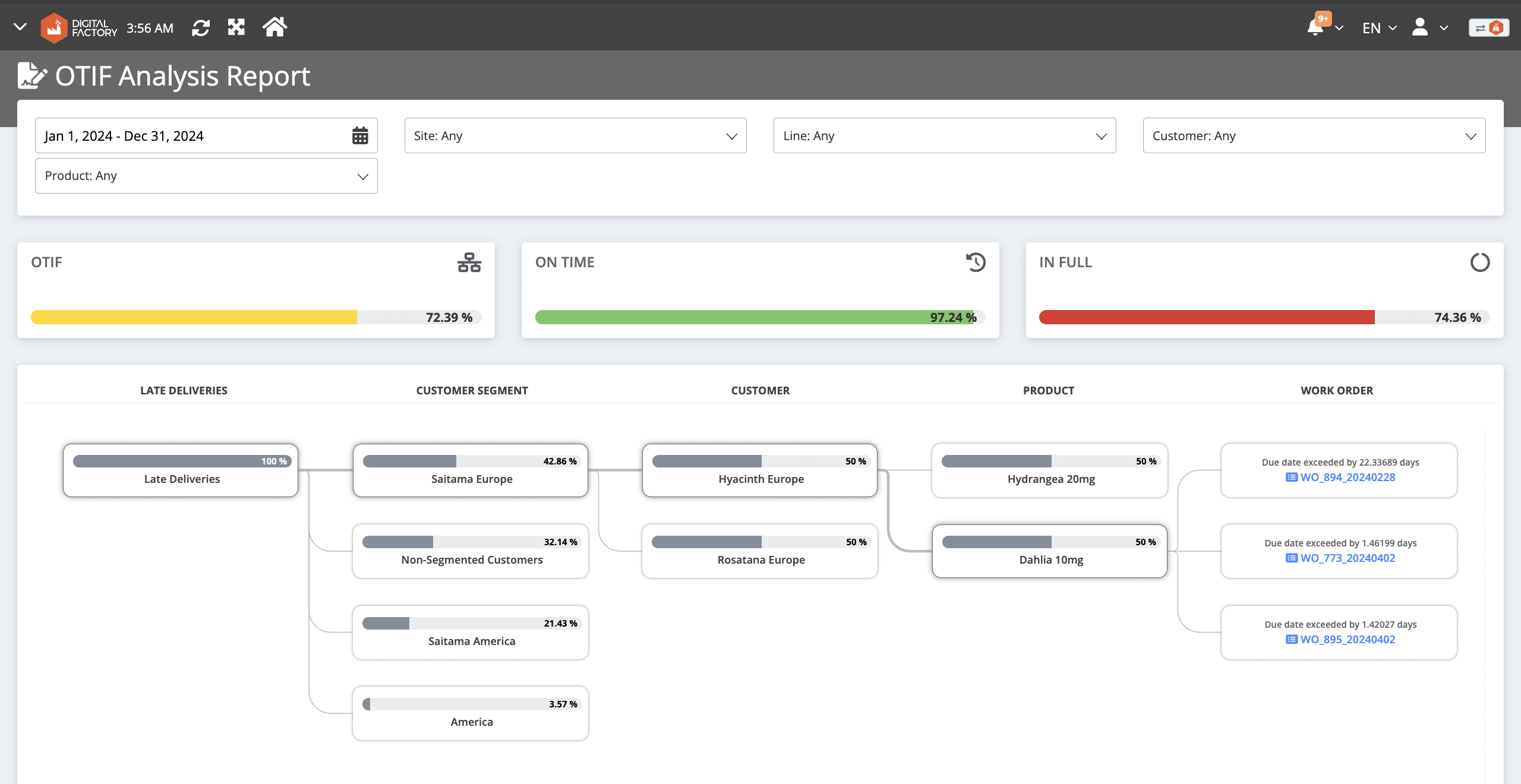
4. Minimize Cost

Cost minimization is another widely used algorithm in our Scheduler. As the image above illustrates, this approach achieves lower costs while maintaining a high OEE. However, cost minimization often involves trade-offs. For example, in this simulation, 12 work orders were left unscheduled to keep costs low, which could be a critical issue for production timelines.
Planners may need to manually adjust these schedules to address such violations, ensuring that all necessary work orders are included without excessively compromising the cost objectives.
5. Maximize Profit

The maximize profit algorithm focuses on scheduling in a way that maximizes overall financial returns. In this simulation, the algorithm scheduled all 88 work orders with a total cost of $70,214. While this approach successfully balances cost and output, it comes with certain trade-offs.
One potential downside is a lower OTIF score, meaning that while the schedule is optimized for profit, it may compromise timely delivery. This can impact customer satisfaction. As always, planners can adjust the schedule manually to address these trade-offs and align with specific business priorities.
Meet with SCW.AI’s Schedule Optimization Software
SCW.AI’s Scheduler Module is a powerful software within our comprehensive Digital Factory Platform, which supports agile manufacturing practices. With advanced AI-driven algorithms, the Scheduler helps planners automate the creation of optimized schedules that align with various business objectives. Then manufacturers can adjust and improve these schedules with a user friendly platform and real-time data.
Want to learn more about how simulation result comparisons with AI algorithms can benefit your business? Contact us today.
Ready to witness the full potential of the Digital Factory Platform, including our Scheduler? Book a demo with us and see it in action.
.


